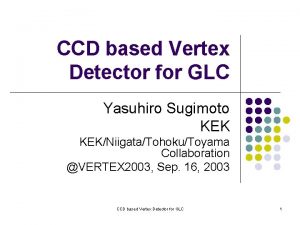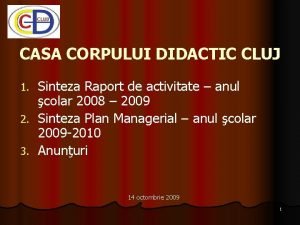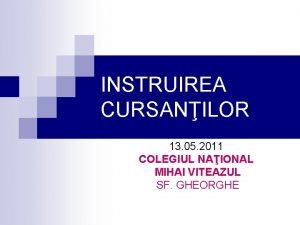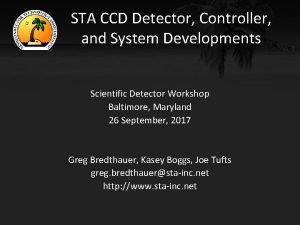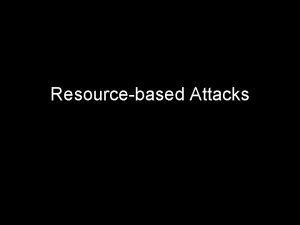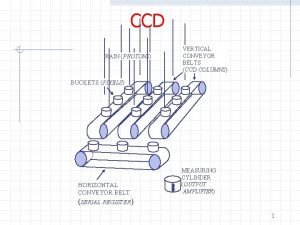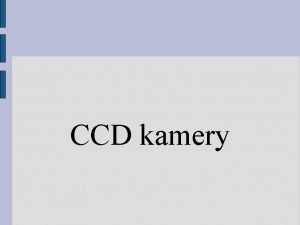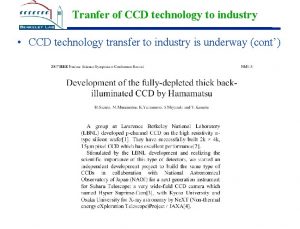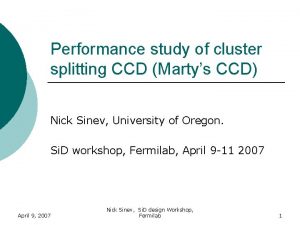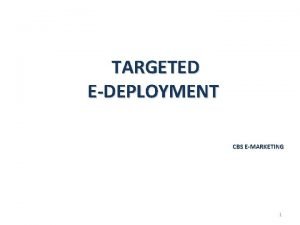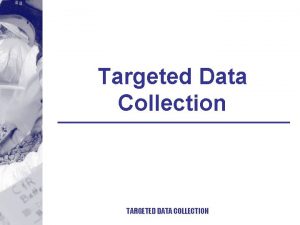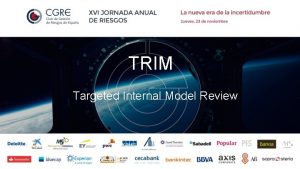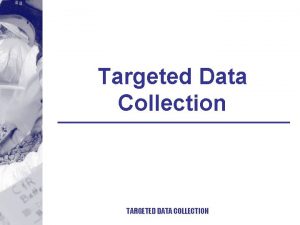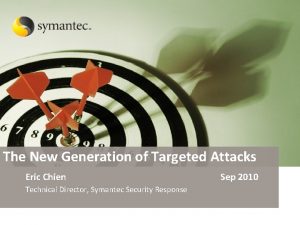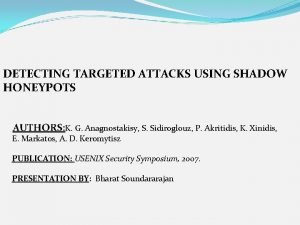CCD course Sandros 3 Targeted attacks on Critical


















































- Slides: 50

CCD course Sandro’s #3: Targeted attacks on Critical Infrastructure

Content OBLIGATORY - The Real Story of Stuxnet, Posted 26 Feb 2013, by DAVID KUSHNER https: //spectrum. ieee. org/telecom/security/the-real-story-of-stuxnet - W 32. Stuxnet Dossier. By Symantec. Read only: Executive Summary, - T. Conway, R. M. Lee, M. J. Assante. Analysis of the cyber attack on the Ukrainian power grid. SANS ICS, 2016. https: //ics. sans. org/media/EISAC_SANS_Ukraine_DUC_5. pdf / name of department 19 -5 -2021 PAGE 1

CRITICAL INFRASTRUCTURE / name of department 19 -5 -2021 PAGE 2

SCADA and PLC (in a nutshell) • SCADA (Supervisory Control and Data Acquisition) - sends control commands to remote devices such as PLCs example of commands: − ‘set the level of water to value x’ − ‘give me the current water flow rate’ − ‘give me the current level of water’ • PLC (Programmable Logic Controller) - process the commands sent by the SCADA makes decisions on its control program in order to produce the output required • SCADA and PLC communicates via industrial protocols such as MODBUS, DNP 3, IEC-104, etc.

General Architecture / name of department 19 -5 -2021 PAGE 4

Protocol by Example: DNP 3 & ICCP • • DNP 3 & ICCP are used mainly electric and water companies. DNP 3 is primarily between a master station and RTUs or IEDs ICCP is used for inter-master station communications. Competing standards: Modbus and IEC 61850 protocol. / name of department 19 -5 -2021 PAGE 6

The trouble with SCADA • Designed 20 Years ago: - Isolated - With no security in mind - Access was local (not remote, there was no internet) • Today - Connected through the backoffice - Allow remote control • In general - Lots of proprietary protocols - Very hard to patch (vendors are very reluctant) • Question: why there are relatively few attacks on SCADA? - We will get back on this. / name of department 19 -5 -2021 PAGE 7

2009: Stuxnet Attack • The first example of Cyber Weapon - Birth Date: Before June 2009 Discovered: June 2010 by Virus. Blok. Ada. Retirement Date: June 24, 2012 # of computers infected: >= 100. 000 • Sources: - The Real Story of Stuxnet, Posted 26 Feb 2013, by DAVID KUSHNER − https: //spectrum. ieee. org/telecom/security/the-real-story-of-stuxnet − Not technical. Obligatory read, there is a lot of FLAME in it - W 32. Stuxnet Dossier. By Symantec − Read: Executive Summary, - Stuxnet Under the Microscope, by ESET (RU) − Too technical for our purposes

Stuxnet: Consequences • Did it serve the purpose? / name of department 19 -5 -2021 PAGE 9

Stuxnet! PHASE 2 PHASE 3 PHASE 1

The attack phases • PHASE 1: an almost normal worm, amazingly smart - It spreads, hides, updates itself (C&C communication) - It looks around − − To duplicate itself TO SEE IF IT CAN ENTER PHASE 2 • PHASE 2: attacking the Siemens + PLC systems - Infects the SIEMENS System - It modifies the PLC programming • PHASE 3: sabotage - Check for a specific factory environment. - If it does not find it, it does nothing - If it finds it changes the speed of the centrifuges 5/19/2021 11 Sandro Etalle

Phase 1: the Windows system • A very elaborate standard worm • To get inside the LAN: USB Sticks • Within a LAN: USB Sticks + Print Spooler, Shared Folders etc • 4 zero-days vulnerabilities - LNK (MS 10 -046) Print Spooler (MS 10 -061) Server Service (MS 08 -067) Privilege escalation Siemens Step 7 project folders • Installs a rootkit that makes it invisible • first checks which antivirus is active then chooses the target executable accordingly. 5/19/2021 12 Sandro Etalle

Phase 1: complexity (part 2) Escalation Of Privileges Surf. CERT meeting Feb 11, 2011, copyright Sandro Etalle

Phase 2: targeted attack • Looks for systems running - Win. CC and PCS 7 SCADA MANAGEMENT PROGRAMS • Finds them even if disconnected (via USB sticks) • It attacks them, exploiting - Hard-wired password (Win. CC) - Uploads as stored procedure - Siemens Project 7 folder vulnerabilities • Hooks into specific Step 7 dll to communicate with the PLC • It replaces the PLC Code • Hides using Rootkit techniques - First PLC rootkit EVER 5/19/2021 14 Sandro Etalle

Phase 3: the targeted part • Designed to hit a specific plant: Stuxnet requires the industrial control system to have frequency converter drives from at least one of two specific vendors, one headquartered in Finland the other in Tehran, Iran. • Stuxnet requires the frequency converter drives to be operating at speeds between 807 Hz and 1210 Hz. Used only in a limited number of applications. • Stuxnet changes the output frequencies and thus the speed of the motors for short intervals over periods of months. • And makes sure that you don’t see it from behind your console http: //www. symantec. com/connect/blogs/stuxnet-breakthrough 5/19/2021 15

Stuxnet summarized • Encryption in ICS – Smart. Grid. Comm ‘ 17 Image by L-Dopa: https: //spectrum. ieee. org/telecom/security/the-real-story-of-stuxnet 16

Stux. Net http: //ebiquity. umbc. edu/blogger/2010/09/23/is-stuxnet-a-cyber-weapon-aimed-at-an-iranian-nuclear-site/

After Stuxnet: Duqu, Flame, Gauss / name of department 19 -5 -2021 PAGE 18

Duqu • History - http: //www. securelist. com/en/blog/208193425/The_mystery_of_Duqu_Part_Ten First in the wild: November 2010? , C&C systems ready as early as 2009 Discovered: September 1, 2011 “Wiped”: October 20, 2011, Reborn: February 2012 (variant) • Spreading mechanism: - Dropper: MS word document, with a 0 -day exploit in it waits until the computer is idle for 10 minutes + other side conditions are met. In the network, then copies itself into a shared folder (using a password stolen with the keylogger) and creates a scheduled job in the target computer. • Same building platform of Stux. Net - “same” vector, different payload default: after 30 days, it wipes itself off only few instances of Duqu found in the wild, unlike Flame. • Purpose - Information gathering on PC contains keylogger espionage software

Flame • • Information-collecting malware. Discovered: May 2012 Much larger and more complex than Stux. Net A different platform, but shares code parts with an early Stuxnet variant • Rumor: “they” started with Stux. Net, and then it became two different projects handled by different teams. • >10. 000 instance found http: //www. wired. com/threatlevel/2012/05/fla me/

Flame (cont) • Spreading mechanism - Dropper: ? ? ? (we don’t know) • Locally: - uses the same print spooler exploit (MS 10 -061) and LNK exploit (MS 10 -046) to spread locally as Stuxnet, and very elaborate MD 5 hash collision attack that enabled Flame to masquerade as a proxy for Windows Update • Collected information - passwords, screenshots, audio, skype conversations, particularly eager to collect pdf and autocad files. Exfiltration collected intelligence is sent remote C&C servers • if no network is available, - saves gathered intelligence on USB sticks, through which it can infect other computers and use their network connections to communicate with the C&C servers.

Gauss • Same platform as Flame - modules: Gauss, Lagrange, Goedel, Taylor • Discovered: June 2012 • Part of it is a “mere” banking trojan - Includes stealing of credentials of social networks, instant messaging, etc • Part of it is the most targeted attack to date: - one of its modules (Goedel) is encrypted in such a way that it can only be decrypted on its target system; has not been decrypted yet http: //www. theregister. co. uk/2012/08 /10/gauss_middle_east_malware/

Red October • infection method “low profile”, but organizationally huge and well-orchestrated • “The attackers have been active since at least 2007, focusing on diplomatic and governmental” • “resistant to C&C server takeover” • “Resurrection module” • terabytes of stolen data • info & images by Kasperski http: //thenextweb. com/insider/2013/01/14/kaspersky-uncovers-red-octobermalware-campaign-targeting-governments-for-the-last-5 -years/


HAVEX DRAGONFLY ENERGETIC BEAR / name of department 19 -5 -2021 PAGE 25

HAVEX: advanced malware • Spread through multiple vectors - E-mail, watering hole attacks, infection of vendors websites and software - 88 observed variants • Main goal: gather information and gain persistent access - Enumeration and qualification of network hosts − Particular interest on OPC servers and VPN connections to PLCs - First step of a cyberwarfare campaign?

Havex/Dragonfly: reconnaissance • The Dragonfly group, (aka Energetic Bear), in operation since at least 2011 … It initially targeted defense and aviation, before shifting its focus to US and European energy firms in early 2013. • phishing emails + watering hole attacks The exploit kit on websites delivered malware to the victim’s computer. The third phase of the campaign was the Trojanizing of legitimate software bundles belonging to three different ICS equipment manufacturers. • Dragonfly bears the hallmarks of a state-sponsored operation, displaying a high degree of technical capability. • Analysis of the compilation timestamps … Based on this information, it is likely the attackers are based in Eastern Europe. • Source: Symantec / name of department 19 -5 -2021 PAGE 27

Havex state sponsored operation? • Dragonfly hacker group - Allegedly Eastern European - In operation since 2011 • Hundreds of organizations affected - Mostly energy companies in Europe and US - More than 1500 infected hosts

Detecting Havex • There are two main behavioral anomalies introduced by Havex that could be exploited for detection. • Detection the moment in which it performs a network scan (not really difficult) • Detection of communication with C&C server (this is generally much more difficult to detect, provided the attackers don’t do something “silly”)

UKRAINE 2015 AND 2016 BLACKENERGY 3 & INDUSTROYER / name of department 19 -5 -2021 PAGE 30

The Ukrainian 2015 Power Grid Attack Black. Energy 3 • December 23 rd , 2015. • affected up to 225, 000 customers in three different distributionlevel service territories and lasted for several hours. / name of department 19 -5 -2021 PAGE 31

The Ukrainian 2015 Power Grid Attack • Malware used: Blackenergy 3 • Sources • T. Conway, R. M. Lee, M. J. Assante. Analysis of the cyber attack on the Ukrainian power grid. SANS ICS, 2016. - Very well done, obligatory read • D. Trivellato, D. Murphy. Lights Out! Who’s Next? - Security. Matter’s Whitepaper available at www. secmatters. com (soon, www. forescout. com) - Less technical

Energy System Overview Picture from: T. Conway, R. M. Lee, M. J. Assante. Analysis of the cyber attack on the Ukrainian power grid. SANS ICS, 2016. • 3 parts: generation, transmission, distribution • Oblenergo = energy company

Ukraine 2015 in a Nutshell • Phishing email containing a malware-rigged attachment. • Different malware components for information gathering, gaining remote access to the victims' ICS network and damaging their SCADA system and other key components, with the goal of delaying process restoration and complicating forensic analysis. Some of the malware used was targeted to specific ICS vendors • The opening of substation breakers to cause the outage. Most likely, the attackers opened the breakers by remotely operating the operators' HMIs. • A denial of service to the utilities' call center, during which the attackers • the target infrastructure to prevent customers from successfully reporting the outage. / name of department 19 -5 -2021 PAGE 34

Stage 1 of the attack • Spear Phishing with word documents - In the attack, the adversary delivered a targeted email with a malicious attachment (a word document) that appeared to come from a trusted source to specific individuals within the organizations. • The documents contained a version of the Blackenergy 3 malware - Black. Energy 3 connected to command control CC - actions to establish persistent access to the targets. • Harvesting of credentials (keyloggers) that could be used to connect directly via VPN (avoiding the use of the CC, more “dangerous”) - Using native connections the attackers certainly did some discovery - In at least one of the oblenergos, the attackers discovered a network connected to a UPS and reconfigured it - the three oblenergos used different distribution management systems (DMSs), and the attackers have customized their tactics to the specific place

Stage 2 (preparation) • Preparation - Attacker learned how to interact with the three Distribution Management Systems (DMS) − They used the native control and operator screens. − They must have done some noise here. - Developed malicious firmware for the serial-to-ethernet devices − They must have had the devices in house to test what they had developed - Installed the Kill. Disk application • Finally: Attack - Primary: Breakers open - Secondary: − Simultaneous upload of new firmware in the serial-to-ethernet devices − Kill. Disk - Supporting − UPS modification − Telephonic floods against at least one oblenergos’ customer support line

The Ukraine 2015 attack in one slide

Ukraine 2015: How could we possibly detect it • Phishing? - Difficult to counter • Watering hole (standard malware)? - Idem • Communication with the C&C: - Possible if the workstation in question does not usually connect to the internet. • Network whitelisting in the internal network - Possibly. “ Silent. Defense would have reported the upload of malicious firmware to the serial-to-ethernet devices, if such operation was performed from a workstation that was not normally used for maintenance operations” / name of department 19 -5 -2021 PAGE 38

One Year Later: Ukraine 2016 • A power cut that hit part of the Ukrainian capital, Kiev, in December has been judged a cyber-attack by researchers investigating the incident. • The blackout lasted just over an hour and started just before midnight on 17 December.

This time it was more automatized • Industroyer (also referred to as Crashoverride) is a malware framework considered to have been used in the cyberattack on Ukraine’s power grid on December 17, 2016. [1] [2] [3] The attack cut a part of Kiev, the capital, off power for one hour and is considered to have been a large-scale test. [4] Industroyer is the first ever known malware specifically designed to attack electrical grids. [5] At the same time, it is the fourth malware publicly revealed to target Industrial Control Systems, after Stuxnet, Havex, and Black. Energy. [5] • Source: Wikipedia • 2018: new report by Dragos (well-done): Anatomy of an Attack: Detecting and Defeating CRASHOVERRIDE, by Joe Slowik, https: //dragos. com/media/CRASHOVERRIDE 2018. pdf • TBD: see whether including it.

Industroyer • Malware specifically designed to attack energy companies • Modular: a backdoor to manage it and specific modules which are designed to gain direct control of switches and circuit breakers at an electricity distribution substation. • Each of these components targets particular communication protocols specified in the following standards: IEC 60870 -5 -101, IEC 608705 -104, IEC 61850, and OLE for Process Control Data Access (OPC DA).

42 Encryption in ICS – Smart. Grid. Comm ‘ 17

It was just a matter of time…

News from 2013 • https: //www. theregister. co. uk/2013/03/20/scada_honeypot_research/ / name of department 19 -5 -2021 PAGE 44

In 2019: Attacks against India’s Energy Sector With an evident increase in the frequency and volume of cyberattacks on India, government sectors are in the foremost line of fire. Explaining the rise of targeted cyber-attacks in India to News 18, Saurabh Sharma, senior security researcher at Kaspersky APAC's global research and analysis team, said, "Most of the cyber attacks on Indian government are targeting the defence and energy sectors. " / name of department 19 -5 -2021 PAGE 45

In 2019: Attacks against India’s Energy Sector (part 2) Researchers identified the malware as a version of Dtrack, a backdoor trojan developed by the Lazarus Group, North Korea's elite hacking unit. Features According to an analysis of the Dtrack malware by Kaspersky, - keylogging, retrieving browser history, gathering host IP addresses, information about available networks and active connections… Dtrack is usually used for reconnaissance purposes and as a dropper for other malware payloads 19 -5 -2021 PAGE 46

SCADA for sale? (1) • ENGERATI, Published: Tue 07 Aug 2018 • https: //www. engerati. com/smartinfrastructure/article/cybersecurity/industrial-control-systems-icsunder-attack-and-sale-days / name of department 19 -5 -2021 PAGE 47

SCADA for sale? (2) • Cybereason researchers who analysed the data collected in a honeypot that masqueraded as a power transmission substation of a major electricity provider. • Judging by how quickly the attackers operated, they’re very familiar with ICS and the security measures that utility providers implement, and know how to move from an IT environment to an OT (operational technology) environment. Just two days after the honeypot went live, attackers had discovered it, prepared the asset for sale on the dark web and sold it to another criminal entity who was also interested in ICS environments. • QUESTION: WHY IS THIS IMPORTANT? / name of department 19 -5 -2021 PAGE 48

QUESTIONS? / name of department 19 -5 -2021 PAGE 49

In Synthesis • Where the Super / name of department 19 -5 -2021 PAGE 50
 Critical semi critical and non critical instruments
Critical semi critical and non critical instruments Spaulding classification system
Spaulding classification system Marketing involve engaging directly with carefully targeted
Marketing involve engaging directly with carefully targeted Targeted local hire
Targeted local hire Consist of your most important targeted or segmented groups
Consist of your most important targeted or segmented groups Mshda dpa
Mshda dpa Targeted youth support islington
Targeted youth support islington Recruitment sources
Recruitment sources Targeted local hire
Targeted local hire Which mcos cover north gsa
Which mcos cover north gsa Targeted early numeracy (ten) intervention program
Targeted early numeracy (ten) intervention program Youtube.com
Youtube.com Ovansertib
Ovansertib Epr effect
Epr effect Targeted disabilities
Targeted disabilities Marketing involve engaging directly with carefully targeted
Marketing involve engaging directly with carefully targeted Targeted solutions tool
Targeted solutions tool Targeted sales elads
Targeted sales elads Targeted local hire program agency referral form
Targeted local hire program agency referral form Slidetodoc.com
Slidetodoc.com Ccd gorj
Ccd gorj Ccdstack
Ccdstack Ccd
Ccd Ccd cluj
Ccd cluj Ccd covasna
Ccd covasna Casa corpului didactic cluj
Casa corpului didactic cluj Community college of denver radiology
Community college of denver radiology Ccd iasi
Ccd iasi Ile camera
Ile camera Ccd cluj
Ccd cluj Ccd neamt
Ccd neamt Ysxxxxxx
Ysxxxxxx Sarnoff ccd
Sarnoff ccd Sky background
Sky background Ccd buzau
Ccd buzau Ccd slogan
Ccd slogan Ccd
Ccd Ccd iasi
Ccd iasi Ccd dsk
Ccd dsk Peralta ccd
Peralta ccd Difference between ccd and ccr
Difference between ccd and ccr Marqueur carbohydrates (ccd)
Marqueur carbohydrates (ccd) Ccd
Ccd Ccd oregon
Ccd oregon Pi ccd
Pi ccd Capteur ccd
Capteur ccd Ccd gorj cursuri
Ccd gorj cursuri Sta ccd
Sta ccd Ccd alias spain
Ccd alias spain One brick t junction in english bond
One brick t junction in english bond Course number and title
Course number and title






















